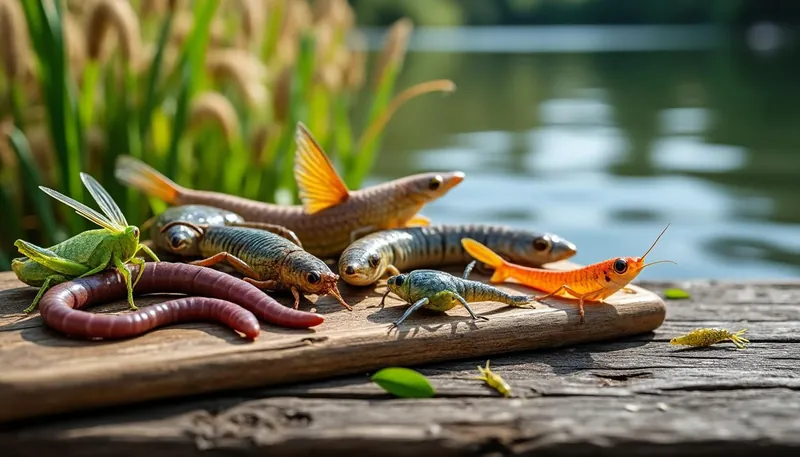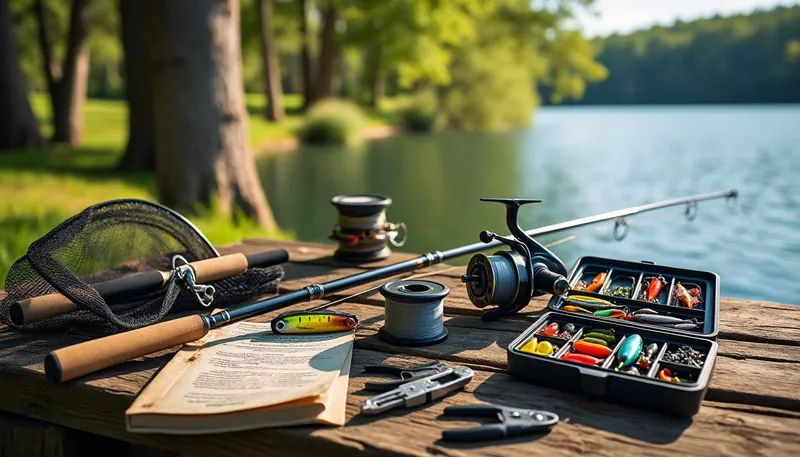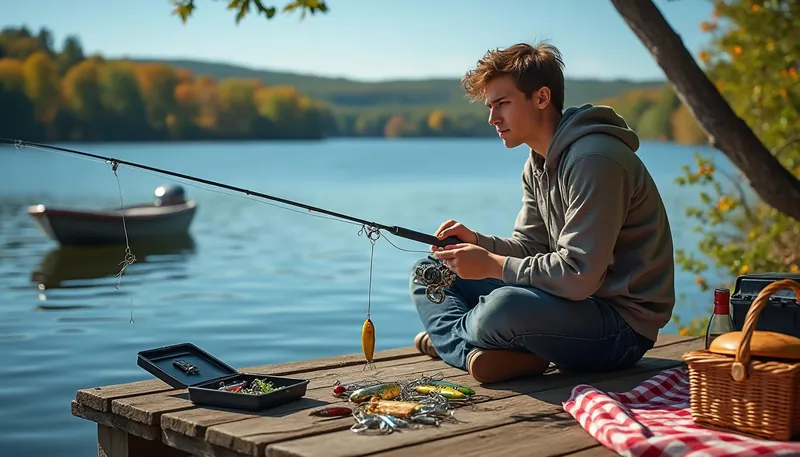Fishing enthusiasts know that using the right bait can significantly increase their chances of a successful catch. When it comes to freshwater fishing, natural baits can provide the advantage anglers need. The variety of baits available can often leave newcomers feeling overwhelmed, but understanding what works best can transform an ordinary fishing trip into an unforgettable experience. Whether you’re targeting bass, trout, or catfish, each species has specific feeding habits that can be exploited with the right bait. Join us as we delve deeper into the best natural baits for freshwater fishing, examining their effectiveness, the species they attract, and how to use them for maximum impact. Get ready to up your fishing game!
In brief:
- Choosing the right bait is crucial for catching specific fish species 🎣.
- Live baits like worms, minnows, and crayfish work wonders for a range of fish 🐟.
- Artificial lures can complement natural baits in certain conditions 🎨.
- Understanding seasonal changes and water conditions helps optimize bait selection 🌦️.
- Trustworthy brands offer effective bait solutions for a successful fishing experience 🏆.
Understanding the Importance of Bait Selection in Freshwater Fishing
Bait selection plays a crucial role in freshwater fishing, directly influencing the success of your catch. Why does it matter so much? Well, the fish in a given body of water tend to develop specific preferences based on the available food sources. By understanding these preferences, anglers can tailor their bait selections to mirror the fish’s natural diet, increasing their allure towards the bait used. Essentially, the right bait can mean the difference between a dry day and reeling in a trophy fish!
Live baits such as worms, minnows, and insects are particularly compelling because they mimic the natural food sources fish are accustomed to consuming. For example, bass and trout often respond positively to small fish like minnows, while catfish are lured in by the scent of live worms or cut bait. Artificial lures also carry their own set of advantages, providing versatility, ease of use, and the ability to cover larger areas quickly. However, those looking to maximize their catch should focus on the use of natural baits, as the organic scent tends to trigger a more instinctive feeding response in many fish species.
It’s essential to note that not all baits work well in every situation. Environmental factors like water temperature, clarity, and depth also influence bait choice. Anglers should always adapt their bait selection to the specific conditions at play for optimal results. Understanding how different bait types perform in varying environments will empower fishers to make informed decisions during their fishing trips.
| Bait Type | Best For | Notes |
|---|---|---|
| Worms 🐍 | Trout, Bass, Panfish | Easy to use; highly effective. |
| Minnows 🐟 | Bass, Walleye, Pike | Great for larger predators; needs a rig. |
| Crayfish 🦞 | Bass, Catfish | Best in rocky areas; mimics natural prey. |
| Insects 🐜 | Trout, Bluegill | Mimics natural insect hatches; season-dependent. |
As anglers, we need to pay attention to the environmental factors we encounter. Doing so will allow us to adapt and enhance our bait selection to ensure maximum efficiency in attracting fish.
Live Bait vs. Artificial Lures: Pros and Cons
When it comes to live bait and artificial lures, each has its own advantages and disadvantages. For those looking to catch fish effectively, understanding the nuances of both types can help refine your approach. Why should you even consider live bait in the first place?
Live bait is often the choice for anglers targeting species that rely heavily on scent and natural movement. Examples include bass, catfish, and bluegill—all species known for their proclivity towards natural offerings. Live bait has an irresistible allure because it mimics the fish’s natural food sources. Worms, minnows, and insects are all go-to options for beginners and seasoned anglers, respectively.
However, using live bait does come with its challenges. Storing live worms and minnows can be tricky, and introducing unfamiliar species into local environments can present ecological problems. Anglers must ensure that they’re fishing responsibly. On the other hand, artificial lures—having gained popularity over the years—provide significant benefits, such as durability, reusability, and the capacity to cover vast areas of water.
| Type | Advantages | Disadvantages |
|---|---|---|
| Live Bait | Mimics natural food; irresistible to fish. | Storage issues; potential ecological risks. |
| Artificial Lures | Durable; various styles and colors available. | May not mimic natural prey; requires precision. |
Ultimately, the choice between live bait and artificial lures often hinges on personal preference, the species being targeted, and the specific fishing conditions. From the tranquil stillness of lakes to the rapid currents of rivers, different baits excel under various circumstances.
Matching Bait with Target Fish Species for Optimal Success
The key to successful fishing lies in matching the right bait with specific fish species. Fish are more likely to bite when the bait closely resembles their natural food sources. For instance, bass will find live minnows and crayfish most appealing, while trout tend to favor worms and larvae. Understanding dietary preferences significantly enhances an angler’s catch rate.
Here are some top choices for various popular game fish:
- Bass: Live bait such as minnows and crayfish, alongside artificial lures like soft plastic worms 🐍.
- Trout: Live worms and insects; dough baits and spinners are effective alternatives too 🌼.
- Panfish (like bluegill and crappie): Small worms and minnows work well; simple jigs are also effective 🎣.
For those just beginning their fishing journey, versatile options like live worms or universal artificial lures serve as excellent entry points. As you become more experienced, take into consideration factors such as the season, water clarity, and the specific habitats present in your fishing location.
| Species | Best Live Bait | Effective Artificial Lures |
|---|---|---|
| Bass | Minows, Crayfish | Soft Plastic Worms, Crankbaits |
| Trout | Worms, Larvae | Dough Baits, Spinners |
| Panfish | Small Worms, Minnows | Simple Jigs |
With practice and observation, angling skills can be fine-tuned, resulting in rewarding fishing trips each time.
Seasonal Preferences and Their Impact on Bait Effectiveness
Weather conditions and seasonal shifts have a profound influence on fish behavior and bait effectiveness in freshwater fishing. As temperatures fluctuate, so do fish habits, making understanding seasonal trends indispensable for anglers. In spring, for example, the warming waters stir fish into aggressive feeding states, making live bait like minnows particularly effective.
During summer, fish often retreat to deeper waters as they seek cooler temperatures. Early morning and late evening remain prime fishing times; adapting your bait selection to include topwater lures, crankbaits, and soft plastics is essential during these times. By fall, fish begin feeding heavily to prepare for winter. Larger lures—like jigs and live minnows—tend to yield fantastic results during this active feeding period.
The colder months, however, demand a different approach. Fish have sluggish metabolisms, so smaller, slow-moving baits like wax worms or soft plastics become increasingly effective. Weather also significantly affects fishing patterns. Overcast days might push fish to shallower waters, while sunny days often draw them into deeper, shaded zones. After a rainstorm, the oxygen levels in the water increase, causing fish to become more active once again.
| Season | Bait Options | Best Times to Fish |
|---|---|---|
| Spring | Live minnows, bright artificial lures | Daytime |
| Summer | Topwater lures, crankbaits, soft plastics | Morning and evening |
| Fall | Jigs, live minnows | All-day |
| Winter | Small baits like wax worms | Midday sun |
By adapting bait choices and strategies according to seasonal changes and weather conditions, anglers can significantly enhance their chances for a successful catch all year round.
Exploring Popular Bait Brands and Products for Freshwater Anglers
The fishing market boasts a plethora of popular bait products designed to enhance the angling experience. Some renowned brands, such as Berkley Gulp!, Uncle Josh, and Lindy, are known for producing bait that resonates well with fish. Berkley’s PowerBait series is especially popular for its scent-infused lures, which attract fish like no other. Similarly, brands like Magic Products and Strike King have created well-regarded offerings that enhance fishing productivity.
The advantage of these name brands lies in their proven effectiveness and innovation. Anglers often benefit from trying baits from the Zoom Bait Company or YUM Baits, especially when targeting specific fish. Choosing the right product based on target fish can amplify the fishing experience immensely. For instance, AquaVu Bait specializes in products that work well in hybrid scenarios, bridging both natural and synthetic offerings.
When selecting bait, consider multiple factors such as your fishing location, target species, and personal preferences. While many anglers gravitate toward time-tested brands, exploring newer or niche products can result in breakthrough success. Reading reviews, getting feedback from fellow anglers, and keeping an open mind can greatly enhance your bait selection process.
| Brand | Notable Bait | Best For |
|---|---|---|
| Berkley Gulp! | PowerBait | Trout, Bass |
| Uncle Josh | Live Bait Alternatives | Catfish |
| Zoom Bait Company | Trick Worms | Panfish, Bass |
| Lindy | Snap Weight | Walleye, Pike |
| Strike King | Spinnerbaits | Bass |
In conclusion, choosing the right bait not only boosts your confidence but also significantly increases your chances of landing that dream catch.
What types of live bait are best for freshwater fishing?
Some of the best live baits include worms, minnows, crayfish, and insects, which effectively attract various species like bass, trout, and bluegill.
How do seasonal changes affect bait selection in freshwater fishing?
Seasonal changes significantly influence fish behavior; during spring, fish become more aggressive, while in winter they tend to be more sluggish, which necessitates different bait choices.
What factors should I consider when selecting artificial lures?
Consider the target species, water clarity, and specific fishing conditions, adjusting color, size, and action accordingly for successful results.
Can I use multiple types of bait simultaneously?
Yes, using various bait types can be very effective, especially in different water conditions or targeting multiple species.
What brands should I look for when buying bait?
Consider reputable brands like Berkley Gulp!, Uncle Josh, and Zoom Bait Company, as they are known for their quality and effectiveness.


